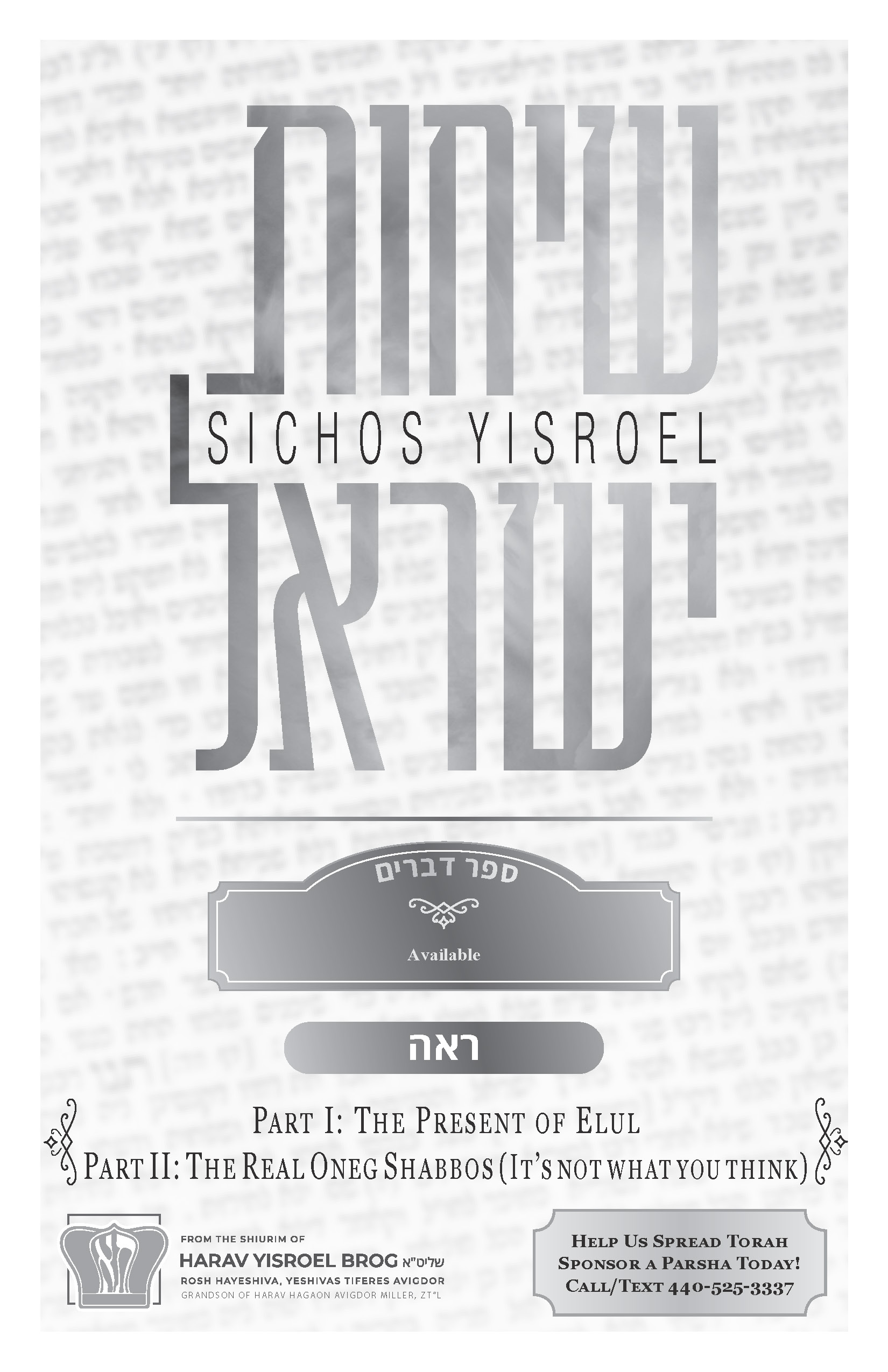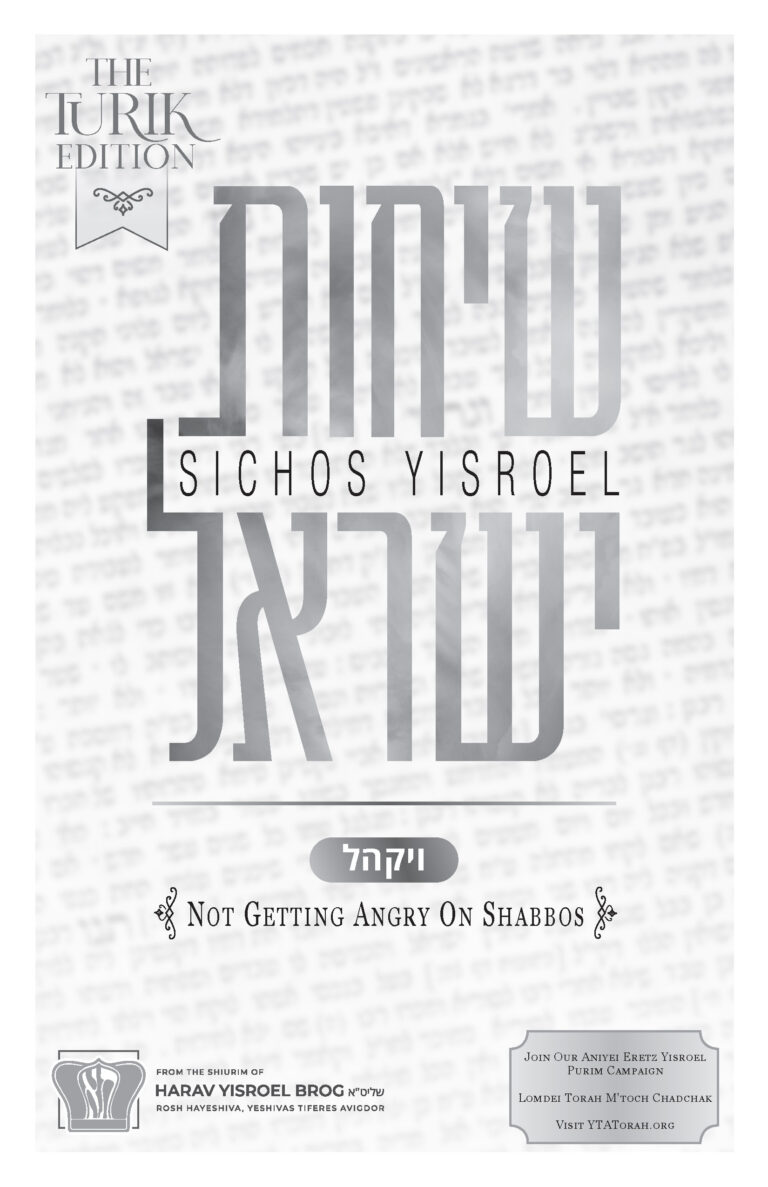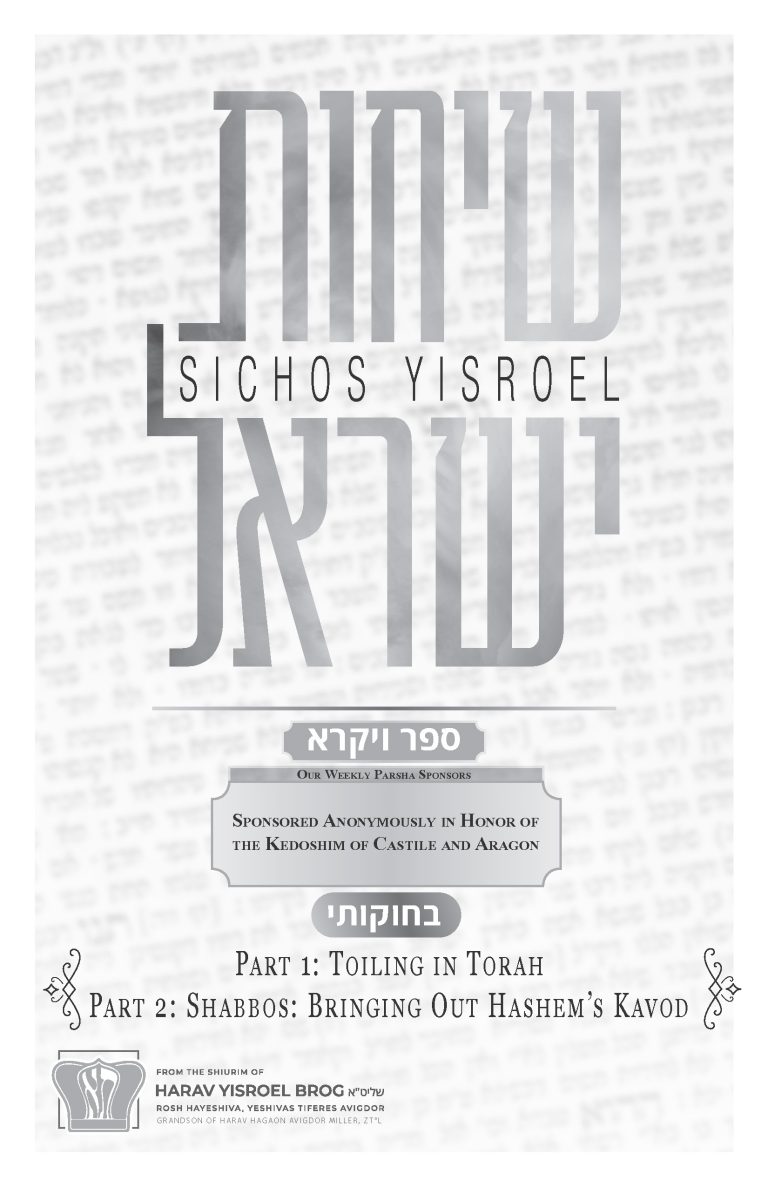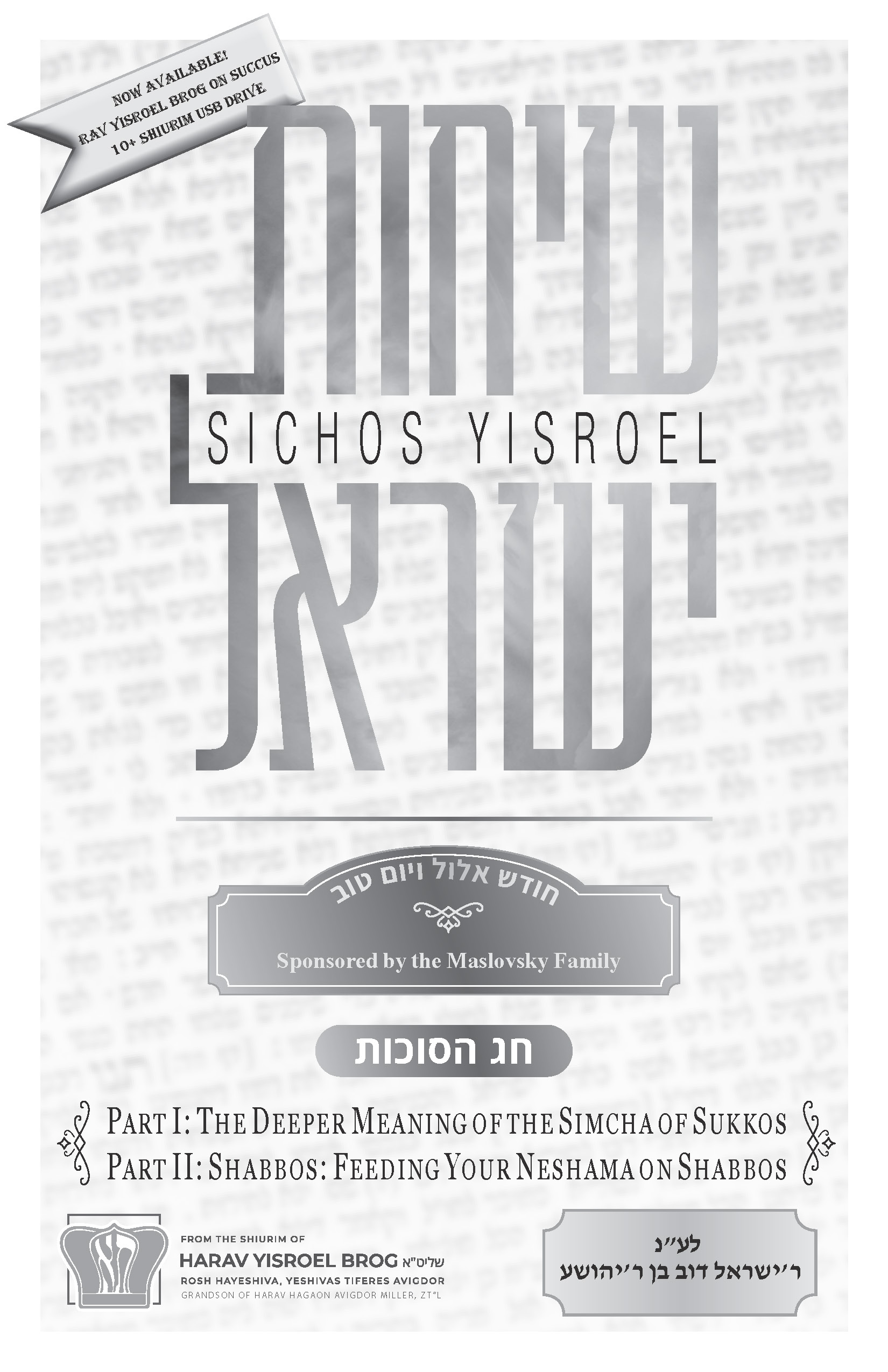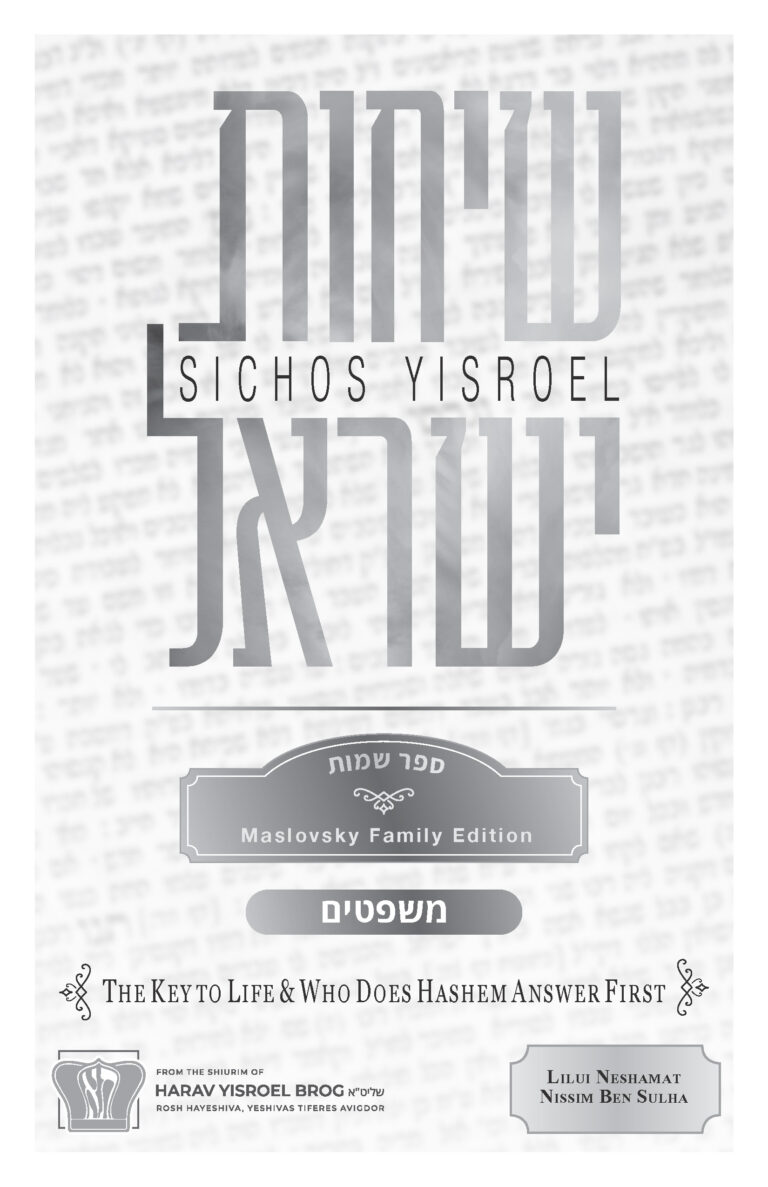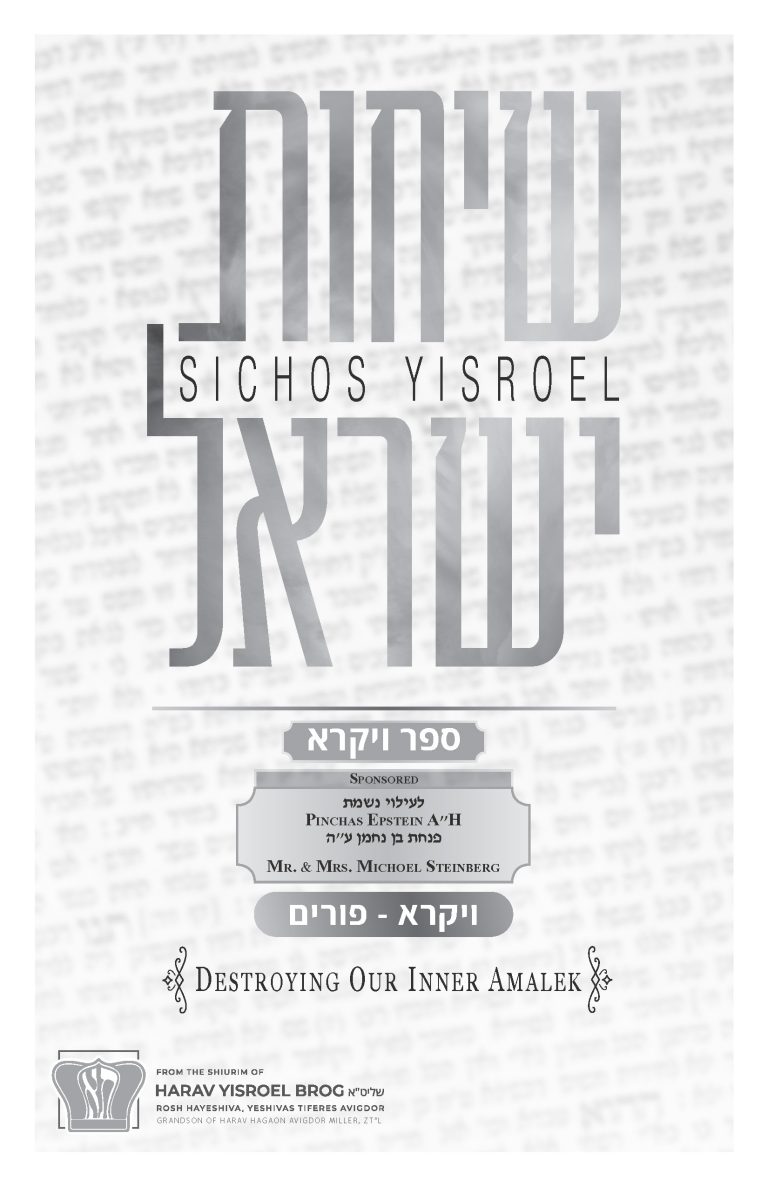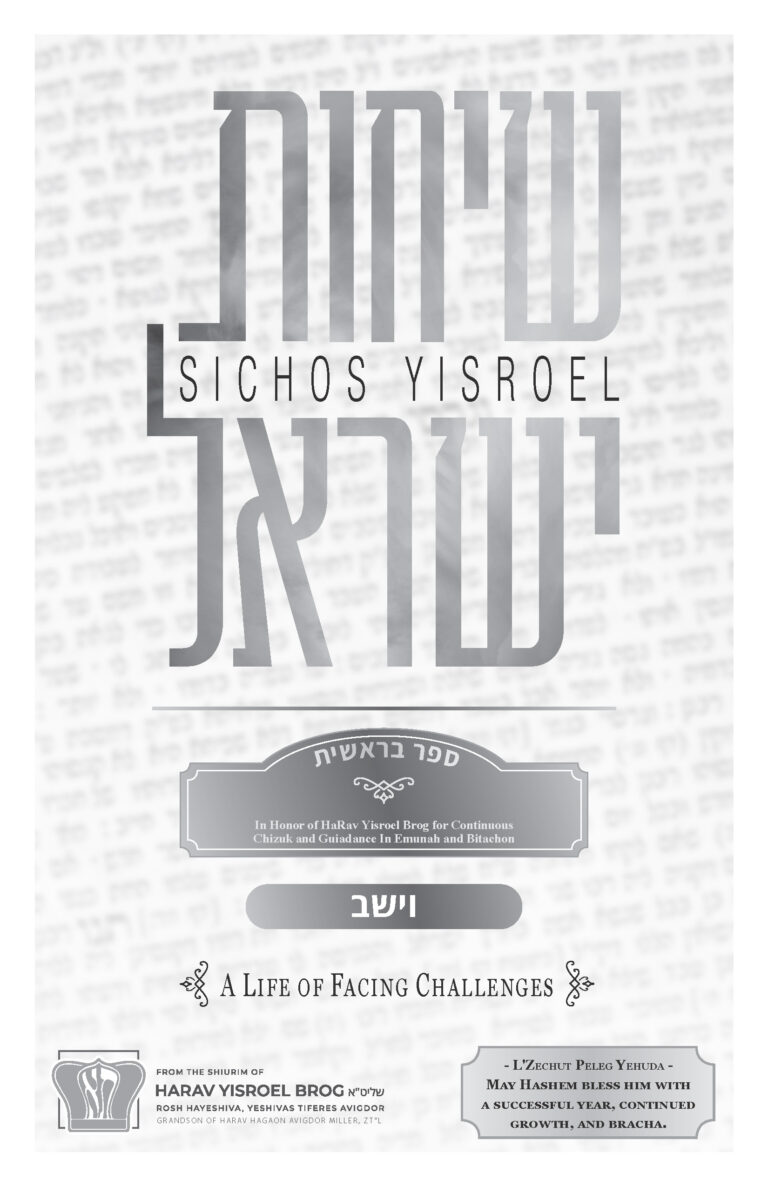Re’eh 5783: The Present of Elul | The Real Oneg Shabbos
Sponsored
In Deep Gratitude to Hashem for the Refuah Shleimah of Yisroel Meir Ben Avigayil
Consider sponsoring a shiur
Visit YTATorah.org
Shiur presented in 5782 and 5770
The Present of Elul
Elul Is All Rachamim
I hope all of you had a wonderful summer and you’re ready now to take on the climb of Chodesh Elul; to gain from it, and not to allow it to pass by in a blur. You have to realize that the shpitz, the end of the journey that begins in Chodesh Elul ends with the conclusion of Yom Hakippurim and hopefully we’ll be zocheh to selichah and mechilah along this journey.
Let us examine some amazing words of the Vilna Gaon (Gr”a) and try to understand them as best as we can. The Gr”a has a compilation of likutim in the end of Sefer Hayetzirah, where he discusses, al pi kabbalah,the secrets that lie behind the months of the year and what they represent. And he says an interesting sentence. He says Elul is כולו רחמים כידוע. That’s what he says. “Elul is complete rachamim as is known.”[i]
Now when you read the words of the Vilna Gaon, you have to analyze each and every word. Can anyone here tell me what is the operative word in this short sentence? Someone says rachamim. Anybody else want to weigh in on this? Someone says kulo. Now, that’s the first half of the sentence. The second half of the sentence is והוא דרגה דחסד, that’s a special level of chessed.
So, let’s try to understand what this means. If you look at the beginning of the Torah, the Torah says בראשית ברא אלקים, “in the beginning Elokim created” (Bereishis 1:1). Rashi cites Chazal who point out that it doesn’t say ‘ברא ה. It says בראשית ברא אלקים. Why? Chazal explain that initially Hakadosh Baruch Hu wanted to create the world only with din, justice.[ii] That means that for every single infraction, on the spot – wham! Bang! There are no returns. According to din, for every single cheit, you are punished immediately. “It’s like jumping off a roof,” as my grandfather (R’ Avigdor Miller) used to always say. Every cheit is like a guy who jumps off the roof. Are there second chances? No. He gets splattered. So Hashem wanted to create the world with middas hadin. A high standard. But ראה, Hashem foresaw, שאין העולם מתקיים, the world could not exist like that. So what did he do? He was הקדים, he preceded to create the world, first, with middas harachamim, the attribute of mercy, ושתפה, and [then] He created a partnership between rachamim and middas hadin. That’s why the pasuk later saysביום עשות ה’ אלקים ארץ ושמים, “on the day that Hashem Elokim made” ארץ ושמים. So when it says בראשית ברא אלקים – that was the original plan. But in actuality, it was ביום עשות ה’ אלקים.
Vus shtait in this passuk? Do you know what the passuk reveals to us? That in order for the world to exist, for the brias haolam to exist and endure, it needed a partnership between the attribute of rachamim and the attribute of din. The world can’t exist just on one middah. And just like Hakadosh Baruch Hu created the world with a partnership of din and rachamim so too Hakadosh Baruch Hu runs the world continually based on din and rachamim.
The Ramban in Sefer Vayikra mentions this concept as well. He says that even Rosh Hashanah, which is the yom hadin, is a yom hadin berachamim.[iii]There’s rachamim also. And Yom Hakippurim which is the yom harachamim, it’s rachamim bedin. So the dominant hanhagah on Rosh Hashanah is din but it has rachamim there, and on Yom Kippur it’s fakhert. The dominant hanhagah is rachamim but it has the shutfus of din.So you see that there always has to be a partnership between these two hanhagos.
Now we can begin to understand the words of the Gr”a. The Gra’s lashon is אלול כלו רחמים. You know what kind of bomb chiddush the Gr”a is dropping on us? You know what he’s telling me? The whole way the world was created was a shutfus of din and rachamim. There’s no such thing as a one middah world! But Elul is the exception to that: אלול כלו רחמים. It’s unbelievable! The Gr”a is saying that even though all the days of the year there’s rachamim and din, Elul is כלו רחמים. There’s no shutfus with middas hadin in Elul. כידוע, I guess for those people who know, it was yadua (known).
And he adds and he says: והוא דרגה דחסד, that’s a tremendous madreigah of chessed. So even though there’s a klal עולם חסד יבנה, Hashem created the world with chessed, but it was chessed, rachamim, but also din. But אלול כלו רחמים.
You Need Rachamim to Do Teshuva!
This is an amazing chessed. If we would only key into it and realize that Elul is an עת רחמים לבד – it’s a time of only rachmanus. Now, of course, the yetzer hara tells us, “Take advantage of this moment to do some aveiros! If it’s only rachamim so chap arein. Come on. Blow it. It’s כלו רחמים.” But the purpose of the rachmanus is to motivate us to amend our ways and for us to prepare ourselves for the great gift of Yom Hakippurim.
Now you can understand the following. People want to know: “What’s the difference between doing teshuvah in Elul or doing teshuvah the whole year?” The whole year you could do teshuvah! There’s no mitzvah of teshuvah just in Elul. There’s a mitzvah of teshuvah all year long! So what’s the difference between Elul and all other months of the year? But now you understand this chodesh is chodesh hateshuvah and I want you to know that to do teshuvah we need a boatload of rachamim. Teshuvah is not a natural thing. Teshuvah goes against all nature. Everybody knows the famous Chazal (Yerushalmi, Makkos 2:6). It says the chachamim were analyzing: What is the tikun for a choteh, for somebody who sins? What was the conclusion of nevuah, of chachmah, of whoever the question was posed to? What was the answer? Yamus, death. By logic there’s no din of teshuvah. Teshuvah is a tremendous rachamim, a tremendous chessed. So Hashem said the teshuvah needs tremendous rachamim and therefore, “I’m going to create a unique month for that rachamim.”[iv]
To give you an idea of how much rachamim a choteh needs, and to give you an appreciation of what Elul is, I will share a gemara with you. The gemara says that after they sinned with the eigel,Moshe went up to Har Sinai. He went up a few times. The third time he went up is when he prepared the new luchos. And it says: ויעבר ה’ על פניו ויקרא ה’ ה’ קל רחום וחנון (Shemos 34:6). That third time began in Chodesh Elul. That’s when it began. That’s when Moshe went up for the last time and he came down [on Yom Kippur with with Hashem’s response, סלחתי כדברך – Hashem granted them forgiveness for the cheit ha’eigel]. In that year Hashem revealed to Moshe thirteen middos of rachamim. I never heard of thirteen middas hadin. I know there’s middas hadin and middas harachamim but He told him there are thirteen different middos harachamim. Unbelievable! Different mesechtos each one. The gemara (Rosh Hashanah 17b) says if the passuk wouldn’t say it, we could never say such a thing – that Hakadosh Baruch Hu demonstrated each middah of rachamim to Moshe Rabeinu. It says ברית כרותה, it was a covenant, a very strong covenant that Hashem made with Klal Yisrael over these thirteen middos harachamim.[v]
The Chiddush of Teshuva that Hashem Created
Now, what are the first two middos harachamim? Hashem Hashem. The first two middos harachamim are one. The gemara (ibid.) says the first shem Hashem refers to the middah of rachamim before a person sins: Hashem says, אני הוא קודם שיחטא. And the second name of Hashem is אני הוא לאחר שיחטא ויעשה תשובה, after he is choteh, when he does teshuvah. Hashem is merachem on us before we do a cheit and He’s merachem on us after the cheit.
You know what you see from here? That middas harachamim loses its power once a person sins. The middas harachamim that exists before a person sins does not extend to after a person sins. Middas harachamim is only in existence naturally by default as long asyou’re not choteh. Once you’re choteh you lose the middas harachamim. It’s an amazing zach. So what did Hakadosh Baruch Hu do? He said, “I have to be mechadesh, I have to create a whole new middah of rachamim, a second middah of rachamim, and that middah of rachamim is for after you sin.” That’s amazing! You hear that?!
The rachamim that exists before a person sins has no power in the world. Once you sinned you forfeit your middas harachamim. You need a new middah of rachamim. Hashem has to create a new world of rachamim. It’s called the olam hateshuvah. A tremendous middah of rachamim.
Now, I would think that if the first rachamim goes together with din, the second rachamim surely goes together with din. But says the Vilna Gaon – no! The even though all year long the second rachamim goes along with din but the rachamim of Elul is כלו רחמים and הוא דרגה דחסד, a gevaldige madreigah of chessed.
I always had a shaylah on this gemara. It says that the second middah of rachamim is לאחר שחטא אדם ויעשה תשובה, for after someone sins and does teshuvah. And Rashi explains: אני מרחם קודם שיחטא ואני מרחם אחר שיחטא אם ישוב.So, I wanted to know what middah exists after you did the cheit before you did teshuvah? You lost the old middas harachamim, and you don’t have the new middas harachamim because you didn’t do teshuvah, so the shaylah is what exists after you did the cheit?
Hashem Hopes We Do Teshuva
There’s a moradige Rabeinu Bachaye in Bamidbar (14:17).[vi]RabeinuBachaye points out that in the parshah of the meraglim,when Klal Yisrael sinned, it only mentions the shem Hashem once. It doesn’t say it twice because after they sinned they lost the first middas harachamim, לפי שישראל היו בכלל חוטאים ולא עשו תשובה, they were sinners at this stage because they hadn’t done teshuvah. And the second middah of Hashem, rachamim, he says, works after one sinned and it treats you as if you didn’t sin, even before you did teshuvah, he says. So even though the gemara says in Rosh Hashanah כאן קודם שיחטא וכאן אחר שיחטא הוא מרחם, Hashem is merachem, he says, אפילו על מי שרובו עונות, even if a guy has a lot of sins, אולי ישוב, maybe he’ll do teshuvah, like it says in the passuk טוב ה’ לכל ורחמיו על כל מעשיו.
Rabeinu Bachaye tells us a moradige yesod here. Even though the gemara says the second middah Hashem is אם ישוב, it means Hashem created that new middah that goes into effect as soon as you do a cheit and it relates to you as if you never did the cheit because Hashem is hoping you will do teshuvah. It’s a moradige insight!
So the first middah of rachamim is a partner with middas hadin. That’s how the world was created. That’s how the world exists. But after you sinned, the middas hadin says: “You have no kiyum. Once you sin you’re finished.” The middas harachamim joins the middas hadin so lechorah there’s no hope for a person! But there’s a new middas harachamim. There’s a new middas harachamim that Hashem creates for after a person sins.
And that’s what Elul is about. Elul is something that’s כולו רחמים -anunusual darga of chessed that we have in Elul that we can exist and we can do teshuvah.
It comes out that the rachmanus that Hashem has on us after a person sins is really a tremendous madreigah of rachmanus, but lema’aseh there is a shituf, there is some partnership with middas hadin, but in Elul it’s כולו רחמים.
In the rishonim you find a lashon that these are days of “ratzon.” These are yemei ratzon. The days of Elul are days of tremendous ratzon. Hashem favors His Bnei Yisrael to such a level and He’s mechadesh new levels of rachmanus. Hashem opens up a new door of rachamim in Elul. So it comes out that there are really two levels in the second middas harachamim. There’s a general middas harachamim and then there’s a unique middas harachamim that has no din along with it. That’s the middas harachamim of Elul. It’s a major chiddush!
Don’t Let This Pass You By
We have to try and appreciate this tremendous gift of Hakadosh Baruch Hu. A great talmid of Rav Yisrael Salanter writes to his son that he spent the previous Elul with Rav Yisrael Salanter, his rebbi, and he darshened almost every single day, and he darshened until after Yom Hakippurim with tremendous emotion but in a different fashion than he usually darshened. He usually darshened with a loud voice but in Elul it was more of a low voice filled with emotion. He says, “I’m going to encapsulate the shoresh of all the shmuzen that he gave. To daven betzibbur for this precious gem that Hashem put into this world and that is Yom Hakippurim; daven that you should have a shaychus to Yom Kippur and don’t let Yom Kippur pass you by without having done some teshuvah, chas veshalom.” You hear that?
There was once a great tzaddik who was on the road during Chodesh Elul on his way to a chasunah. On the road, he encounters a very strange sight. A young person is beating an older person without any rachmanus; zets after zetz like he’s trying to kill him. So this tzaddik, Rav Michel, stopped his wagon and he attempted to ask the young man, “Why are you hitting this guy?!” The man said, “This person I’m hitting is my father. We have a small vineyard and the family is supported from its produce the entire year. Now it’s the time to harvest the grapes, and our entire parnasah for the whole year depends on this harvest. If we’re going to be lazy about it we’re going to lose our livelihood and later we’re going to regret it and it’s going to be too late. My father is a lazy bum and he’s not undertaking to be responsible for the vineyard. I can’t take it. I can’t take how blind he is. And therefore I’m beating him.”
Rav Michel heard this and he said, “What a goy understands, I shouldn’t understand?!” He said, “I’m now holding in Elul. These are the yemei haratzon. If a guy is going to be lazy and lackadaisical about what he can accomplish right now and what he needs to do right now, he’s going to lose out on his whole shefa, brachah and hatzlachah in the future! So how did I allow myself to undertake this trip and go to a simchah?!”
Rabbosai, we have a tremendous opportunity in this coming Chodesh Elul. Let us utilize it to correct ourselves, to make amendments, to prepare ourselves, and not to act in a risky manner. Let us all hope and daven that we should be zocheh for a little kapparah on Yom Hakippurim and that we should have a good year.
Part II: The Real Oneg Shabbos (It’s not what you think) – 5770
The Mitzvas Asei of Oneg Shabbos
The navi Yeshayah (58:13) tells us about Shabbos. He gives tochachah to Klal Yisrael and he says אִם תָּשִׁיב מִשַּׁבָּת רַגְלֶךָ, “if you turn back your feet [from violating techum Shabbos],” עֲשׂוֹת חֲפָצֶיךָ, “to do your desires” – i.e. if you refrain from doing melachah for your own business, בְּיוֹם קָדְשִׁי, “on Hashem’s holy day,” and then it says, וְקָרָאתָ לַשַּׁבָּת עֹנֶג, “you shall call Shabbos delight.” Hashem wants you to call the Shabbos an oneg.
In the first part of the passuk Yeshayah says, you have to refrain from transgressing the mitzvos lo sa’asei. That’s thefirst step. That means not to transgress the issurim, such as techum Shabbos and the melachos.
Then he talks about the mitzvos asei. The asei is וקראת לשבת עונג. What does וקראת לשבת עונג mean? There is a moiradige Radak (R’ Dovid Kimchi, 1160-1235) who explains this message of Yeshayah Hanavi.[vii] HaKadosh Baruch Hu refers to Shabbos as yom kodshi. Why? שאני קדשתי אותו, I sanctified Shabbos. The Torah writes in the beginning of Parshas Bereishis, ויקדש אותו, HaKadosh Baruch Hu was mekadesh the zeman of Shabbos. והקדוש הוא שהבדילו משאר הימים. HaKadosh Baruch Hu was the one who separated the day of Shabbos from the rest of the days, so it is His day of holiness.[viii] Now what does this mean?
Shabbos is Hashem’s Day
HaKadosh Baruch Hu was miskadesh certain zemanim in the year that are unique from other zemanim. For example, there is Zeman Cheiruseinu. What does zeman cheiruseinu mean? That means Hashem was posei’ach, He opened up a gateway from Himself to the Bnei Yisrael, that He is now giving them a shefa of cheirus. That pesichas sha’ar remains open forever and ever. There is Zeman Matan Toraseinu, which meansHaKadosh Baruch Hu was posei’ach a sha’ar for Matan Torah. It remains a pesichas sha’ar forever and ever.
If a person is ra’oy, if he prepares himself to be mekabel from that zeman, he could walk through that zeman, and come out on the other side a different person.
So when HaKadosh Baruch Hu is posei’ach the sha’ar of kedushah in Shabbos Bereishis, at the beginning of brias haolam, HaKadosh Baruch Hu says, “This is the sha’ar of kedushah.” It follows therefore that HaKadosh Baruch Hu says, “I want you not to do melachah beyom kodshi.”
Indulge on Shabbos – Time for Oneg!
It says וקראת לשבת עונג. The Radak explains that אם תשיב משבת refers to mitzvos lo sa’asei and וקראת לשבת עונג refers to the mitzvos asei.[ix] Now think what are the mitzvos asei of Shabbos? The mitzvos lo sa’asei of Shabbos are extremely vast. There are 39 melachos, with so many toldos, similar situations. The gemara says hilchos Shabbos is mamish from the difficult halachos. They are numerous. But what are the mitzvos asei of Shabbos? [The answer is,] וקראת לשבת עונג. It’s a pele. What does that mean? מצות עשה לענג הגוף ביום השבת במאכלים ערבים וטובים. There is pashut a mitzvas asei, he says, the first and foremost mitzvas asei of Shabbos, is to indulge the body with pleasures on Shabbos, such as sweet and good foods. That’s pshat of וקראת לשבת עונג!
So what וקראת לשבת עונג means, is that on Shabbos your conduct should not only reflect that it is a special and a different day by not doing melachah, but it is supposed to reflect that it is a day of oneg. How does Shabbos reflect that it is a day of oneg? על ידי מצות עשה לענג את הגוף ביום השבת במאכלים ערבים וטובים.
Eat, To Remember!
Now, he says what’s the pshat? שמתוך שישנהו משאר ימים לטוב במאכלים ערבים וטובים – Hashem wants us to be meshaneh, to change the day of Shabbos, לטוב, in a positive way, from all other days with מאכלים ערבים וטובים. What is the purpose of that? Why does Hashem want me to be me’aneg my guf במאכלים ערבים וטובים? The answer is that if you will do this, יזכור מעשה בראשית – you are going to be zocher maaseh Bereishis, you are going to remember maaseh Bereishis. ושהקל חדשו מאין and you will remember that HaKadosh Baruch Huwas mechadesh the briah, He created a brand-new world, יש מאין ושבת ביום השביעי, and He stopped and rested on the seventh day. That’s step number one, he says.
So the whole purpose of having a seudah tonight, the whole purpose of having a seudah tomorrow, the whole purpose of having snacks on Shabbos is for what? יזכור, it has to cause a zechirah. It has to kick in your memory. It has to jog your mind to something. If a person eats מאכלים ערבים וטובים and let’s say it ‘kills his mind.’ Instead of giving him and causing him any zechirah, not only does he not remember anything, he forgets everything. It’s not unusual. The proof is that a lot of times when a guy eats on Shabbos, his mind goes blank. He blanks out. He goes into a kind of a coma. Has anyone ever told you:“I can’t think now.” After eating you can’t think. But the whole purpose of the oneg is that you are having a good time on Shabbos and the good time has to be, yizkor, in order to help a person remember.
And what is supposed to be the next step? ומתוך כך, once you will remember, ישבח לקל you are now going to express בפה, verbally, shevach for Hashem. ויפארהו בפיו ובלבבו and you will glorify Him with your mouth and in your heart, ותתענג נפשו בו and then you will enjoy being with Hashem. You will appreciate and you will then be zoche ’להתענג על ה. That’s what the Radak says.
Remembering, In Order to Praise
One of the ways that we accomplish zechirah is by giving hoda’ah to Hashem. You have to understand the hoda’ah to Hashem is an expression befiv, with the mouth to be meshabei’ach Hashem, to praise Hashem, to be mefo’er Hashem, to glorify Hashem. To express to HaKadosh Baruch Hu, “I appreciate everything You have done for me. In addition to You being the borei olam, in addition to You being מחדש בטובו בכל יום תמיד מעשה בראשית, You cared for me.” HaKadosh Baruch Hu wants me to remember and to express that.
Now, how important is this on Shabbos? The answer is, it is very important. Where do we see this? We can see it from the changes we make in the tefillah for Shabbos, from the regular tefillos of the weekday. Not only is the tefillas Shemoneh Esrei different, but we change a specific part of the tefillah. Not the brachos of birkas hashachar, nor the pesukei d’zimrah. There are some hosafos, but we are not meshaneh the etzem pesukei dezimrah.
We do change the brachos of birchos krias shema in the morning. Not the second birchos krias shema but the first brachah. Over there, what we do is, we express our shevach, appreciation and wonder for HaKadosh Baruch Hu over His briah and we say a whole different nusach than we say every day.
Emulating Hashem’s Oneg Shabbos
We have to understand two things from this message. Number one, the day of Shabbos is like no other day. The briah, the world on Shabbos, the maaseh Bereishis on Shabbos is chaluk, separate from the maaseh Bereishis of the other six days. Number two, HaKadosh Baruch Hu is mekadesh this day. On this day it says: לקל אשר שבת מכל המעשים ביום השביעי התעלה, Hashem is elevated, וישב על כסא כבודו תפארת עטה ליום המנוחה עונג קרא ליום השבת.
What does it mean when it says עונג קרא ליום השבת? We know that Hashem told us through Yeshayah that we should call Shabbos oneg, וקראת לשבת עונג. What does it mean that HaKadosh Baruch Hu was עונג קרא ליום השבת?
The answer to that question is found in the She’ilta (d’Rav Achai Gaon, 680-752).[x] In the She’ilta it says דמחייבין דבית ישראל למינח, [we have to] rest on Shabbos, because when HaKadosh Baruch Hu created the world, He created it in six days and He rested on Shabbos. He was mevarech the Shabbos. He was mekadesh the Shabbos. He says, on Shabbos, Hashem did the same thing that a person who builds a house does. When a person builds a house and the house is set up and he completes the work, you know what he does? He makes a hilullah, he makes a party. חד יומא, he celebrates one day. It’s called הילול בתי, a chanukas habayis.
Shtait over here a gevaldige zach. He says, just as HaKadosh Baruch Hu was shomer Shabbos, HaKadosh Baruch Hu also fulfilled oneg kara leyom haShabbos. HaKadosh Baruch Hu Himself kept the halachos. The hanhagah of HaKadosh Baruch Hu on Shabbos is one of shevisah beShabbos. HaKadosh Baruch Hu also has a minhag to be me’aneg es haShabbos. Our oneg Shabbos is bedugmah shel maaleh. We emulate HaKadosh Baruch Hu in His oneg Shabbos.
How do we do oneg Shabbos? We do it in a physical way. We start in the physical way, but the physical must lead you further, otherwise you are being mechalel HaKadosh Baruch Hu. You are taking the oneg of Shabbos, but you are not allowing yourself to reach the purpose of the oneg Shabbos.
Appreciating the World and Praising Hashem On Shabbos, Or, Zzzz?
It’s like saying to Hashem, “I don’t care about Your oneg Shabbos. My oneg Shabbos is to give myself a good sleeping pill.” Many people do that, you should know. They take oneg Shabbos just as a sleeping pill. When you daven tomorrow morning and say, הַכּל יודוּךָ – “All will thank You,” you should think, “HaKadosh Baruch Hu as a result of the appreciation of the physical enjoyment I have had on Shabbos, I am now going to express myself. First I am going to remind myself in my mind that You are taka the Borei olam, You are מחדש בטובו כל יום תמיד מעשה בראשית, and then I am going to be meshabei’ach and mefo’er that Borei olam. I am going to celebrate this great day of Shabbos with You, HaKadosh Baruch Hu, and I am going to be misaneg, come to a taanug hanefesh. I want to have a taanug hanefesh on Shabbos. However, if a person has a taanug haguf that undermines his taanug hanefesh, then Rachmana litzlan, he is missing the boat, he is missing the message of Shabbos and he is chas veshalom not doing the ratzon of HaKadosh Baruch Hu.
The Bottom Line
For the world to exist and endure, it has to run on continued and necessary partnership of both middos of din and rachamim, as Chazal teach us. The incredible chidduch of the Gr”a that chodesh Elul is כולו רחמים – rachamim alone, without any middas ha’din – is especially amazing in light of above principle of constant partnership of these two הנהגות. Elul is therefore the momentous exception to this rule of the creation. And of course the idea that Elul is כולו רחמים, is there to motivate us to change, so that we can prepare for Yom Kippur and do teshuva, for which we need as much rachamim as possible. We also learned, that similarly to how Hashem was mekadesh certain zmanim with specific השפעות (i.e. חירות on Pesach and מתן תורה on Shavuos) – to allow us to tap into their special spiritual koach and be transformed by that spiritual energy – Hashem also established Shabbos as a gateway of kedusha, available for us every week for us to tap into as well. Apart from sanctifying Shabbos by abstaining from melachos, we also have a positive mitzvah of וקראת לשבת עונג – to indulge the body with pleasures of delicious foods – but with the ultimate goal of remembering מעשה בראשית as a vehicle to praising and glorifying Hashem, and being zoche to reach the madregah of ’להתענג על ה on Shabbos!
[i] ליקוט. חדשי החמה מלמטה למעלה. ניסן במלכות, אייר חדש זיו [יסוד] ששם נמנו ישראל, ועיין בזוהר ריש פרשת במדבר. סיון נו”ה [הלוחות] שניתנו לישראל וכן במזלות. ניסן טלה [קרבן] פסח כרחל כוי. אייר שור, בכור שורו יוסף כוי. סיון תאומים תרי פלגי דגופא. תמוז ת”ת. אב גבורה מזל אריה גימט’ גבורה ובו היה מה שהיה. אלול כולו רחמים כידוע והוא דרגא דחסד, וששה חדשי הגשמים סוד דדכורא מלמעלה למטה, אבל הכל בנוק’ כי החדשים בנוק’, ולכן ניסן ראשון לחדשים אבל שנים בסטרא דדכורא ולכן מונין מתשרי. וידוע שז’ הוא בדכורא וי”ב בנוק’. ולכן שנים הם בסוד שבע, וחדשים בסוד שנים עשר (הגר”א בליקוטים סוף ספר יצירה ,סוד החודשים)
[ii] ברא אלקים וְלֹא נֶאֱמַר בָּרָא ה’, שֶׁבַּתְּחִלָּה עָלָה בְמַחֲשָׁבָה לִבְרֹאתוֹ בְּמִדַּת הַדִּין, רָאָה שֶׁאֵין הָעוֹלָם מִתְקַיֵּם, הִקְדִּים מִדַּת רַחֲמִים וְשִׁתְּפָהּ לְמִהַ”דִּ, וְהַיְינוּ דִּכְתִיב בְּיוֹם עֲשׂוֹת ה’ אֱלֹהִים אֶרֶץ וְשָׁמָיִם.
[iii] וכוי, ועל דרך האמת תרועה היא שעמדה לאבותינו ולנו שנאמר (תהלים פט טז) אשרי העם יודעי תרועה וכענין שכתוב (ירמיהו ד יט) תרועת מלחמה כי השם איש מלחמה אם כן “יום תרועה יהיה לכם” שיהיה היום לתרועה לנו וכן “זכרון תרועה מקרא קדש” שיהיה הזכרון בתרועה ולפיכך הוא מקרא קודש ולא הוצרך להזכיר שופר כי השופר רמז ב”יום” והתרועה בו והנה הוא יום דין ברחמים לא תרועת מלחמה ומפני זה הזכיר הכתוב התרועה שכבר קבלה ביד רבותינו וכל ישראל רואים עד משה רבינו שכל תרועה פשוטה לפניה ופשוטה לאחריה ולמה יזכיר הכתוב תרועה ולא יזכיר התקיעות כלל לא בראש השנה ולא ביום הכפורים אבל התקיעה היא הזכרון והוא השופר והתרועה כשמה ומפני שהיא כלולה מן הרחמים תקיעה לפניה ולאחריה ולפיכך אמר ב”יודעי תרועה” כי בצדקה ירומו כי תפארת עוזמו אתה והנה זה מבואר כי הכל תלוי בתשובה אלא בראש השנה מתיחד במדת הדין ומנהיג עולמו וביום הכפורים במדת הרחמים והוא מאמרם (ר”ה לב) מלך יושב על כסא דין וכו’ ראש השנה יום דין ברחמים ויום הכפורים יום רחמים בדין ומן הענין שפירשנו תבין טעם הכתוב במסעות (במדבר י ו ז) תרועה יתקעו למסעיהם ובהקהיל את הקהל תתקעו ולא תריעו כי במסעיהם כתוב ויסע מלאך האלהים (שמות יד יט) וכתוב ויפוצו אויביך וינוסו משנאיך מפניך (במדבר י לה) כטעם פני ה’ בעושי רע (תהלים לד יז) ובהקהיל את הקהל נאמר (במדבר י לו) שובה ה’ רבבות כטעם ויהי בישורון מלך בהתאסף ראשי עם יחד (דברים לג ה) ועשרת הימים שבין ראש השנה ליום הכפורים ירמוז לעשר ספירות כי ביום הכפורים יתעלה בהם ויגבה ה’ צבאות במשפט כידוע בקבלה וגם יש בזה אות בשמים שהחדש הזה מזלו מאזנים כי בו פלס ומאזני משפט לה’. (רמב”ן על ויקרא כ״ג:כ״ד)
[iv] שאלו לחכמה. חוטא מהו עונשו. אמרה להם. חטאים תרדף רעה. שאלו לנבואה. חוטא מהו עונשו. אמרה להן. הנפש החטאת היא תמות שאלו לקודשא בריך הוא. חוטא מהו עונשו. אמר להן. יעשה תשובה ויתכפר לו. היינו דכתיב. על־כן יורה חטאים בדרך. יורה לחטאים דרך לעשות תשובה. כתיב כצפור לנוד כדרור לעוף כן איש נודד ממקומו.
[v] ״ויעבור ה׳ על פניו ויקרא״. אמר רבי יוחנן: אלמלא מקרא כתוב, אי אפשר לאומרו. מלמד שנתעטף הקדוש ברוך הוא כשליח צבור, והראה לו למשה סדר תפלה. אמר לו: כל זמן שישראל חוטאין – יעשו לפני כסדר הזה ואני מוחל להם. ״ה׳ ה׳״ – אני הוא קודם שיחטא האדם, ואני הוא לאחר שיחטא האדם ויעשה תשובה – ״אל רחום וחנון״. אמר רב יהודה: ברית כרותה לשלש עשרה מדות שאינן חוזרות ריקם, שנאמר: ״הנה אנכי כורת ברית״.
[vi] ובמסכת ראש השנה ה’ ה’, כאן קודם שיחטא אדם ויעשה תשובה כאן לאחר שיחטא ויעשה תשובה. והוא מרחם אפילו על מי שרובו עונות אולי ישוב, וכענין שכתוב (תהלים קמה) טוב ה’ לכל ורחמיו על כל מעשיו. אבל כאן לא הזכירו אלא פעם אחת שהוא כנגד ה’ לאחר שיחטא, לפי שישראל היו בכאן חוטאים ולא עשו תשובה. ובאור זה ה’ לאחר שיחטא כי אין בו שינוי והתפעלות אחר החטא כקודם החטא, מה שאין כן במלך בשר ודם.
[vii] ביום קדשי. שאני קדשתי כמו שאמר ויקדש אותו, והקדוש הוא שהבדילו משאר הימים, ופירוש עשות חפציך מעשות, ומ”ם משבת עומדת במקום שנים, ורגלך, וחפצך, חסרים יו”ד הרבים, ורבותינו זכרונם לברכה פירשו רגלך דרך המקרא לשון רבים שאמרו רגלו אחת בתוך התחום ורגלו אחת חוץ לתחום יכנס שנאמר אם תשיב משבת רגלך, רגליך קרינן, כלומר אף על פי שכתוב רגלך בלא יו”ד יש אם למקרא.
[viii] וכן אנו אומרים בתפילת קדושת היום, דהיינו: אתה קדשת את יום השביעי לשמך וכו’, וקדשתו מכל הזמנים וכו’, ויברך אלקים את יום השביעי ויקדש אותו וכו’.
[ix] וקראת לשבת עונג. אם תשיב משבת, מצות לא תעשה, וקראת לשבת עונג, מצות עשה לענג הגוף ביום השבת במאכלים ערבים וטובים שמתוך שישנהו משאר ימים לטוב יזכור מעשה בראשית ושהאל חדשו מאין ושבת ביום השביעי ומתוך כך ישבח לקל ויפארוהו בפיו ובלבבו, ותתענג נפשו בו, ופי’ וקראת כמו מקרא קדש.
[x] שאילתא דמחייבין דבית ישראל למינח ביומא דשבתא דכד ברייה קודשא בריך הוא לעלמיה ברייה בשיתא יומי ונח ביומא דשבתא וברכיה וקדשיה כאיניש דבני ביתא וכד מצבית ליה וגמר ליה לעיבידתיה עביד הילולא חד יומא כדאמרי אינשי הילול בתי דכתיב ויכל אלהים ביום השביעי ואמר לן רחמנא נוחו ביומא דשבתא כי היכי דנחי ביה אנא דכתיב זכור את יום השבת לקדשו ואסור לאיענויי ביה אלא מתבעי ליה לבר ישראל לאיענוגי ביה במיכלא ובמשתיא ויקוריה בלבושא ובכיסויא מעליא דכתיב וקראת לשבת עונג וכבדתו שלא יהא מלבושך של שבת כמלבושך של חול, וכו’. (שאילתות דרב אחאי גאון א׳)
